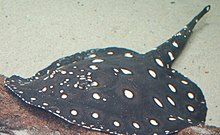Freshwater stingrays
| Freshwater stingrays | ||||||||||||
|---|---|---|---|---|---|---|---|---|---|---|---|---|

Pfauenaugen stingray ( Potamotrygon motoro ) |
||||||||||||
| Systematics | ||||||||||||
|
||||||||||||
| Scientific name | ||||||||||||
| Potamotrygonidae | ||||||||||||
| Garman , 1877 |
The freshwater stingrays (Potamotrygonidae), short freshwater rays , are a family of rays living in South America , as well as the only family of cartilaginous fish , most of which are found in freshwater . They include five genera with currently around 40 known species . The family is the subject of current research, with many species not being described until the 2010s.
The Potamotrygonidae are probably monophyletic and development line of stingray-like , which the mouth of the Uramazonas lived, as this age or in the Pacific flowed. By the folding of the Andes they were cut off from their previous habitat. The family likely developed at the end of the Cretaceous or early Tertiary . The Potamotrygonidae are fossilized from the Eocene . By reducing the rectal gland and the low urea content in the blood, they show their adaptation to fresh water.
In a broader sense, the term freshwater stingrays and some live in rivers species from the related family of stingrays (Dasyatidae) as the Asian Laos stingrays , Makararaja chindwinensis and the three species of the genus Fluvitrygon .
features
Freshwater stingrays are often circular, and the Paratrygon genus is slightly longer than wide. They have no dorsal fins and no caudal fin. The tail is whip-shaped, with a venomous, barbed stinger. A new stinger grows back every 6 to 12 months.
Their color is usually brown, gray or black with a drawing of colored dots, spots or circles. Depending on the species, they reach a diameter of 25 centimeters to just over a meter (exception 1.5 or 2 m in the case of Styracura ).
Reproduction
Like most rays, freshwater rays are viviparous ( ovoviviparous ). They have internal fertilization. Usually between two and seven, more rarely up to twelve young fish are born that may still have remains of the yolk sac .
distribution
The freshwater stingrays are native to the tropical zones of South and Central America. However, they only live in rivers that flow into the Atlantic or the Caribbean , but not in the basin of the Rio São Francisco . Most species only live in a river system, some endemic only in a certain river (e.g. Potamotrygon leopoldi ). Few species, such as Potamotrygon motoro and Potamotrygon orbignyi , have a wider range that includes multiple river systems.
Genera
There are two subfamilies, the actual freshwater stingrays (Potamotrygoninae) and the marine Styracurinae. Altogether the Potamotrygonidae comprise five genera, the genus Potamotrygon containing over 25 species and four others, to which only two or one species belong.
- Subfamily Potamotrygoninae
- Genus Heliotrygon Carvalho & Lovejoy, 2011
- Heliotrygon gomesi De Carvalho & Lovejoy, 2011
- Heliotrygon rosai De Carvalho & Lovejoy, 2011
- Genus Paratrygon Duméril, 1865
- Paratrygon aiereba ( Müller & Henle , 1841)
- Plesiotrygon Rosa genus , Castello et Thorson, 1987
- Plesiotrygon iwamae Rosa, Castello & Thorson, 1987
- Plesiotrygon nana de Carvalho & Ragno, 2011
- Genus Potamotrygon Garman, 1877
- Genus Heliotrygon Carvalho & Lovejoy, 2011
- Subfamily Styracurinae Carvalho et al., 2016
- Genus Styracura , Carvalho et al., 2016
- Styracura pacifica (Beebe & Tee-Van, 1941)
- Styracura schmardae (Werner, 1904)
- Genus Styracura , Carvalho et al., 2016
literature
- Joseph S. Nelson: Fishes of the World , John Wiley & Sons, 4th Edition, 2006, ISBN 0-471-25031-7
- Hans Gonella: Guide to freshwater rays . Bede, Ruhmannsfelden 1997, ISBN 978-3-931792-39-8 .
- Frank Schäfer: Potamotrygonidae. In: Claus Schaefer, Torsten Schröer (Hrsg.): The large lexicon of aquaristics. 2 volumes. Eugen Ulmer, Stuttgart 2004, ISBN 3-8001-7497-9 , p. 805.
Individual evidence
- ↑ Carvalho, MRd, Loboda, TS & Silva, JPCBd (2016): A new subfamily, Styracurinae, and new genus, Styracura , for Himantura schmardae (Werner, 1904) and Himantura pacifica (Beebe & Tee-Van, 1941) (Chondrichthyes : Myliobatiformes). Zootaxa , 4075 (3): 201-221. doi: 10.11646 / zootaxa.4175.3.1
Web links
- Freshwater stingrays on Fishbase.org (English)
- www.potamotrygon.de



